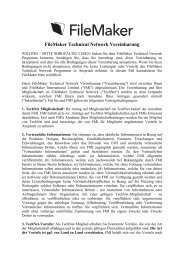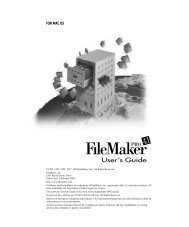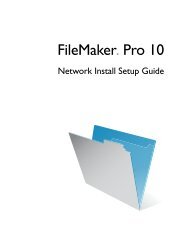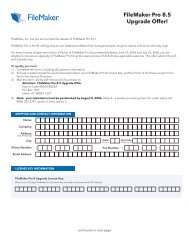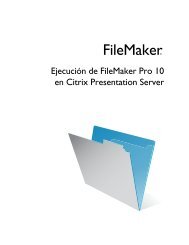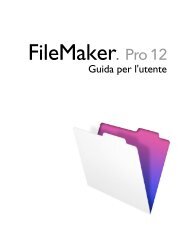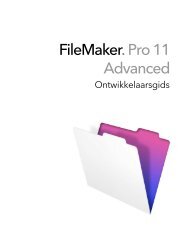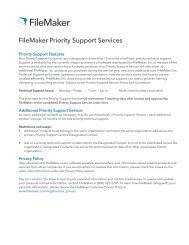Guida di FileMaker Server 12
Guida di FileMaker Server 12
Guida di FileMaker Server 12
You also want an ePaper? Increase the reach of your titles
YUMPU automatically turns print PDFs into web optimized ePapers that Google loves.
Protezione dei dati<br />
Protezione dei dati<br />
Nota Le seguenti informazioni sono destinate ad amministratori server.<br />
È possibile sfruttare <strong>di</strong>verse funzioni <strong>di</strong> <strong>FileMaker</strong> <strong>Server</strong> per rendere i dati più sicuri sia per i client<br />
<strong>FileMaker</strong> Pro sia per i client Web:<br />
• Crittografare la connessione tra il server database e i client <strong>FileMaker</strong> e tra il server<br />
database e il Motore per la Pubblicazione Web. Sia le informazioni che i dati dell’account<br />
utente sono protetti grazie alla crittografia Secure Sockets Layer (SSL). Fare clic su <strong>Server</strong><br />
database > scheda Sicurezza e abilitare Proteggi connessioni al <strong>Server</strong> database.<br />
Vedere la sezione Impostazioni <strong>di</strong> sicurezza del server database.<br />
• Creare un certificato firmato che corrisponda al sistema dei nomi server o dei nomi <strong>di</strong><br />
dominio (DNS) per una connessione SSL completamente sicura con <strong>FileMaker</strong> <strong>Server</strong>.<br />
Per ulteriori informazioni, vedere Comando CERTIFICATO.<br />
• Per pubblicare i database per i client Web, attivare la crittografia SSL sul server Web per<br />
crittografare i dati trasmessi dal server Web ai computer ospiti sul Web.<br />
Se si attiva la crittografia SSL sul server Web, è necessario utilizzare l’Assistente <strong>di</strong>stribuzione<br />
per configurare <strong>FileMaker</strong> <strong>Server</strong> e utilizzare il protocollo HTTPS per comunicare con il server<br />
Web. L’Assistente <strong>di</strong>stribuzione prova a rilevare il server Web utilizzando il protocollo HTTP;<br />
quin<strong>di</strong> se il server Web utilizza HTTPS, l’Assistente non riesce a trovarlo e richiede ulteriori<br />
informazioni. Nel passo Test server Web fallito dell’Assistente <strong>di</strong>stribuzione, selezionare<br />
HTTPS e continuare. Vedere la sezione Mo<strong>di</strong>fica <strong>di</strong> una <strong>di</strong>stribuzione <strong>FileMaker</strong> <strong>Server</strong>.<br />
Per informazioni sull’abilitazione e la configurazione <strong>di</strong> SSL sul server Web, consultare la<br />
documentazione del server Web.<br />
• È possibile attivare e <strong>di</strong>sattivare determinati privilegi estesi, come PHP, XML, e<br />
Pubblicazione Web Imme<strong>di</strong>ata per il Motore per la Pubblicazione Web. Ad esempio, se si sa<br />
che tutti i file su un server saranno con<strong>di</strong>visi con Pubblicazione Web personalizzata con<br />
PHP, è possibile <strong>di</strong>sattivare tutti gli altri tipi <strong>di</strong> Pubblicazione Web. Anche se un file<br />
comprende privilegi estesi che permettono <strong>di</strong> accedere ai dati XML, l’accesso ai dati XML<br />
non è consentito mentre il file è ospitato con tale <strong>di</strong>stribuzione <strong>FileMaker</strong> <strong>Server</strong>. Per<br />
attivare o <strong>di</strong>sattivare una tecnologia <strong>di</strong> Pubblicazione Web per tutti i file su <strong>FileMaker</strong> <strong>Server</strong>,<br />
fare clic su Pubblicazione Web, quin<strong>di</strong> sulla scheda PHP, XML, o Pubblicazione Web<br />
Imme<strong>di</strong>ata. Su ciascuna <strong>di</strong> queste schede è possibile attivare o <strong>di</strong>sattivare la Pubblicazione<br />
Web per tutti i database ospitati, anche se per questi è attivato il relativo privilegio esteso.<br />
Vedere la sezione Configurazione delle impostazioni <strong>di</strong> Pubblicazione Web.<br />
• È possibile consentire a <strong>FileMaker</strong> <strong>Server</strong> <strong>di</strong> autenticare gli utenti attraverso un server <strong>di</strong><br />
autenticazione esterno come una Open Directory <strong>di</strong> Apple o una Active Directory <strong>di</strong> Windows.<br />
Per ulteriori informazioni vedere Autenticazione esterna per l’accesso al database.<br />
• Se la propria organizzazione utilizza un servizio <strong>di</strong> <strong>di</strong>rectory LDAP, è possibile abilitare Usa<br />
SSL (Secure Sockets Layer) nell’assistente del servizio <strong>di</strong> <strong>di</strong>rectory per crittografare i nomi<br />
utente e le password che i client <strong>FileMaker</strong> <strong>Server</strong> e <strong>FileMaker</strong> Pro utilizzano per accedere<br />
al server LDAP. Vedere le sezioni Impostazioni client <strong>FileMaker</strong> Pro e Specifica delle<br />
impostazioni del servizio <strong>di</strong> <strong>di</strong>rectory.<br />
• Attivare i file <strong>di</strong> registro <strong>FileMaker</strong> <strong>Server</strong> per controllare gli accessi ai database. Vedere la<br />
sezione Visualizzazione delle voci <strong>di</strong> registro.<br />
Nota Per ulteriori informazioni vedere "Creazione <strong>di</strong> account che eseguono l’autenticazione<br />
attraverso un server esterno" nella <strong>Guida</strong> <strong>di</strong> <strong>FileMaker</strong> Pro e www.filemaker.com/it/support/security.<br />
GUIDA DI FILEMAKER SERVER <strong>12</strong> <strong>12</strong>6



